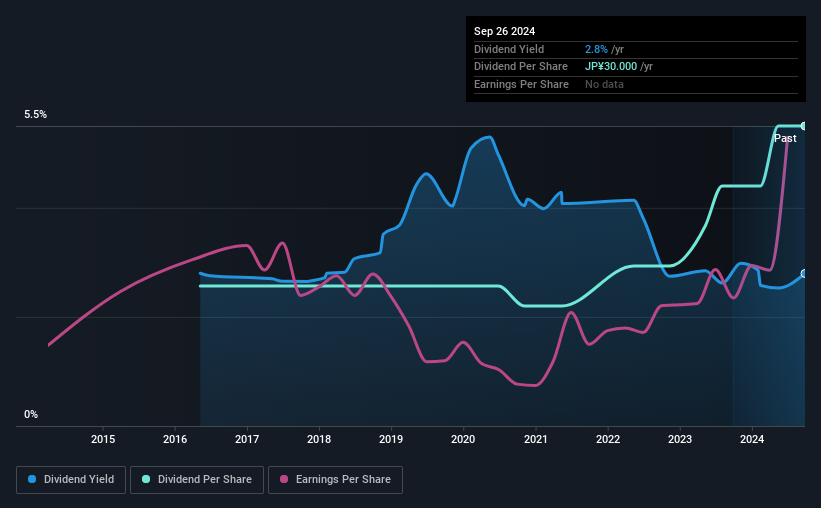First Bank Of Toyama (TSE:7184) Is Increasing Its Dividend To ¥15.00

The First Bank Of Toyama, Ltd. (TSE:7184) will increase its dividend from last year's comparable payment on the 5th of December to ¥15.00. This makes the dividend yield about the same as the industry average at 2.8%.
See our latest analysis for First Bank Of Toyama
First Bank Of Toyama's Dividend Forecasted To Be Well Covered By Earnings
We like a dividend to be consistent over the long term, so checking whether it is sustainable is important.
First Bank Of Toyama has established itself as a dividend paying company, given its 8-year history of distributing earnings to shareholders. While past data isn't a guarantee for the future, First Bank Of Toyama's latest earnings report puts its payout ratio at 16%, showing that the company can pay out its dividends comfortably.
If the trend of the last few years continues, EPS will grow by 34.9% over the next 12 months. Assuming the dividend continues along recent trends, we think the future payout ratio could be 15% by next year, which is in a pretty sustainable range.

First Bank Of Toyama's Dividend Has Lacked Consistency
It's comforting to see that First Bank Of Toyama has been paying a dividend for a number of years now, however it has been cut at least once in that time. This makes us cautious about the consistency of the dividend over a full economic cycle. The dividend has gone from an annual total of ¥14.00 in 2016 to the most recent total annual payment of ¥30.00. This means that it has been growing its distributions at 10.0% per annum over that time. We have seen cuts in the past, so while the growth looks promising we would be a little bit cautious about its track record.
The Dividend Looks Likely To Grow
Growing earnings per share could be a mitigating factor when considering the past fluctuations in the dividend. First Bank Of Toyama has seen EPS rising for the last five years, at 35% per annum. A low payout ratio gives the company a lot of flexibility, and growing earnings also make it very easy for it to grow the dividend.
First Bank Of Toyama Looks Like A Great Dividend Stock
In summary, it is always positive to see the dividend being increased, and we are particularly pleased with its overall sustainability. Earnings are easily covering distributions, and the company is generating plenty of cash. All of these factors considered, we think this has solid potential as a dividend stock.
It's important to note that companies having a consistent dividend policy will generate greater investor confidence than those having an erratic one. Still, investors need to consider a host of other factors, apart from dividend payments, when analysing a company. Taking the debate a bit further, we've identified 2 warning signs for First Bank Of Toyama that investors need to be conscious of moving forward. If you are a dividend investor, you might also want to look at our curated list of high yield dividend stocks.
If you're looking to trade First Bank Of Toyama, open an account with the lowest-cost platform trusted by professionals, Interactive Brokers.
With clients in over 200 countries and territories, and access to 160 markets, IBKR lets you trade stocks, options, futures, forex, bonds and funds from a single integrated account.
Enjoy no hidden fees, no account minimums, and FX conversion rates as low as 0.03%, far better than what most brokers offer.
Sponsored ContentNew: AI Stock Screener & Alerts
Our new AI Stock Screener scans the market every day to uncover opportunities.
• Dividend Powerhouses (3%+ Yield)
• Undervalued Small Caps with Insider Buying
• High growth Tech and AI Companies
Or build your own from over 50 metrics.
Have feedback on this article? Concerned about the content? Get in touch with us directly. Alternatively, email editorial-team (at) simplywallst.com.
This article by Simply Wall St is general in nature. We provide commentary based on historical data and analyst forecasts only using an unbiased methodology and our articles are not intended to be financial advice. It does not constitute a recommendation to buy or sell any stock, and does not take account of your objectives, or your financial situation. We aim to bring you long-term focused analysis driven by fundamental data. Note that our analysis may not factor in the latest price-sensitive company announcements or qualitative material. Simply Wall St has no position in any stocks mentioned.
About TSE:7184
First Bank Of Toyama
Provides banking and financial services for individual, corporate, and business customers.
Solid track record with adequate balance sheet.
Market Insights
Community Narratives



